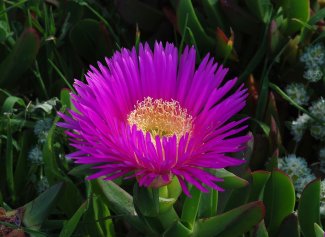Southern South America: Argentina - Chubut; Chile
A succulent shrub (family Aizoaceae) found throughout coastal California and the Channel Islands, especially in areas with a warm winter climate. Carpobrotus chilensis may have been introduced during early Spanish settlement. It now inhabits coastal scrub, grasslands, chaparral, bluffs, dunes and beaches, where it creates dense mats that increase soil organic matter over time, allowing new non-native species to invade. Carpobrotus chilensis has long stems and fleshy, pointed leaves which are triangular in cross-section. Its flowers are magenta and are smaller than those of ice plant.
Carpobrotus chilensis may have been introduced during early Spanish settlement. Most of the material currently found in California is probably of hybrid origin, potentially from five species. In previous floras, California material has been misidentified as Carpobrotus aequilaterus Haworth, which was published with a description of vegetative characters only and no type specimen. A. H. Haworth (1812) stated that it was most closely related to Mesembryanthemum elongatum Haworth, which today would be assigned to Conicosia. S. T. Blake (1969) selected two Salm-Dyck illustrations to typify C. aequilaterus. One illustration, from Chile, has been identified by the Bolus Herbarium in South Africa as C. deliciosus L. Bolus, a species from southwest Africa. The second illustration matches horticultural material in Australia but not material collected in California. Historical material collected in San Diego was identified by John Torrey in 1854 as Mesembryanthemum dimidiatum Haworth, now Carpobrotus dimidiatus (Haworth) N. E. Brown, from southeast Africa. The introduction would likely have been from Portuguese ships traveling around the Cape of Good Hope to the east in the 1500s. Material identified as C. dimidiatus is also found on the Juan Fernandez Islands off Chile, a reprovisioning stop for early sailing vessels. There is more recently introduced material in California of C. edulis, C. acinaciformis (Linnaeus) L. Bolus, and C. quadrifidus L. Bolus from southwest Africa. Of those, only C. edulis has naturalized.

